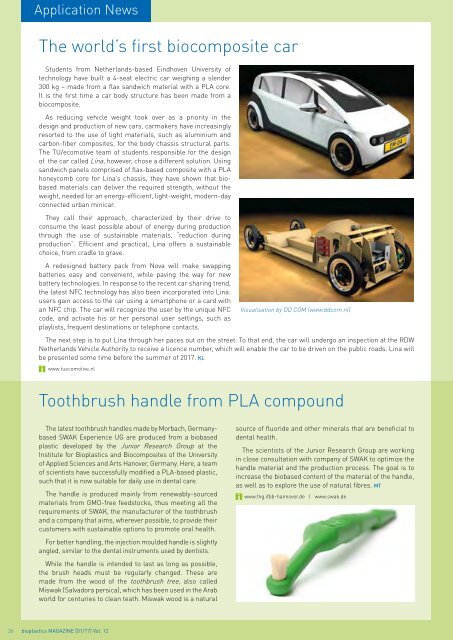Issue 01/2017
bioplasticsMAGAZINE_1701
bioplasticsMAGAZINE_1701
You also want an ePaper? Increase the reach of your titles
YUMPU automatically turns print PDFs into web optimized ePapers that Google loves.
Application News<br />
The world’s first biocomposite car<br />
Students from Netherlands-based Eindhoven University of<br />
technology have built a 4-seat electric car weighing a slender<br />
300 kg – made from a flax sandwich material with a PLA core.<br />
It is the first time a car body structure has been made from a<br />
biocomposite.<br />
As reducing vehicle weight took over as a priority in the<br />
design and production of new cars, carmakers have increasingly<br />
resorted to the use of light materials, such as aluminium and<br />
carbon-fiber composites, for the body chassis structural parts.<br />
The TU/ecomotive team of students responsible for the design<br />
of the car called Lina, however, chose a different solution. Using<br />
sandwich panels comprised of flax-based composite with a PLA<br />
honeycomb core for Lina’s chassis, they have shown that biobased<br />
materials can deliver the required strength, without the<br />
weight, needed for an energy-efficient, light-weight, modern-day<br />
connected urban minicar.<br />
They call their approach, characterized by their drive to<br />
consume the least possible about of energy during production<br />
through the use of sustainable materials, “reduction during<br />
production”. Efficient and practical, Lina offers a sustainable<br />
choice, from cradle to grave.<br />
A redesigned battery pack from Nova will make swapping<br />
batteries easy and convenient, while paving the way for new<br />
battery technologies. In response to the recent car sharing trend,<br />
the latest NFC technology has also been incorporated into Lina:<br />
users gain access to the car using a smartphone or a card with<br />
an NFC chip. The car will recognize the user by the unique NFC<br />
code, and activate his or her personal user settings, such as<br />
playlists, frequent destinations or telephone contacts.<br />
Visualisation by DD COM (www.ddcom.nl)<br />
The next step is to put Lina through her paces out on the street. To that end, the car will undergo an inspection at the RDW<br />
Netherlands Vehicle Authority to receive a licence number, which will enable the car to be driven on the public roads. Lina will<br />
be presented some time before the summer of 2<strong>01</strong>7. KL<br />
www.tuecomotive.nl<br />
Toothbrush handle from PLA compound<br />
The latest toothbrush handles made by Morbach, Germanybased<br />
SWAK Experience UG are produced from a biobased<br />
plastic developed by the Junior Research Group at the<br />
Institute for Bioplastics and Biocomposites of the University<br />
of Applied Sciences and Arts Hanover, Germany. Here, a team<br />
of scientists have successfully modified a PLA-based plastic,<br />
such that it is now suitable for daily use in dental care.<br />
The handle is produced mainly from renewably-sourced<br />
materials from GMO-free feedstocks, thus meeting all the<br />
requirements of SWAK, the manufacturer of the toothbrush<br />
and a company that aims, wherever possible, to provide their<br />
customers with sustainable options to promote oral health.<br />
For better handling, the injection moulded handle is slightly<br />
angled, similar to the dental instruments used by dentists.<br />
While the handle is intended to last as long as possible,<br />
the brush heads must be regularly changed. These are<br />
made from the wood of the toothbrush tree, also called<br />
Miswak (Salvadora persica), which has been used in the Arab<br />
world for centuries to clean teath. Miswak wood is a natural<br />
source of fluoride and other minerals that are beneficial to<br />
dental health.<br />
The scientists of the Junior Research Group are working<br />
in close consultation with company of SWAK to optimize the<br />
handle material and the production process. The goal is to<br />
increase the biobased content of the material of the handle,<br />
as well as to explore the use of natural fibres. MT<br />
www.fng.ifbb-hannover.de | www.swak.de<br />
26 bioplastics MAGAZINE [<strong>01</strong>/17] Vol. 12


















